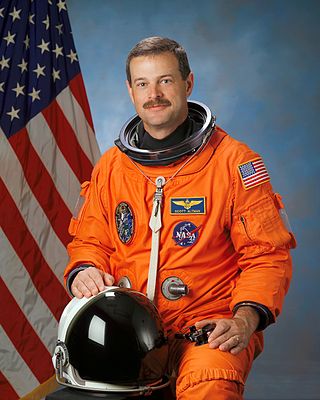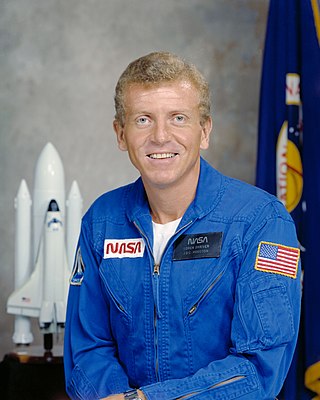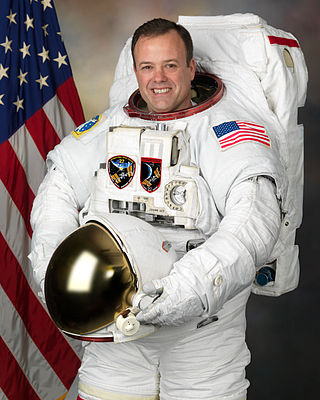
Michael Phillip Anderson was a United States Air Force officer and NASA astronaut. Anderson and his six fellow crew members were killed in the Space Shuttle Columbia disaster when the craft disintegrated during its re-entry into the Earth's atmosphere. Anderson served as the payload commander and lieutenant colonel in charge of science experiments on the Columbia. Anderson was posthumously awarded the Congressional Space Medal of Honor.

Eileen Marie Collins is a retired NASA astronaut and United States Air Force (USAF) colonel. A former flight instructor and test pilot, Collins was the first woman to pilot the Space Shuttle and the first to command a Space Shuttle mission.

Scott Douglas "Scooter" Altman is a retired United States Navy Captain and naval aviator, engineer, test pilot and former NASA astronaut. He is a veteran of four Space Shuttle missions. His fourth mission on STS-125 was the last servicing mission to the Hubble Space Telescope. As of November 2022, he is the president of the Space operating group for ASRC Federal.

Kenneth Dwane "Sox" Bowersox is a United States Navy officer, and a former NASA astronaut. He is a veteran of five Space Shuttle launches and an extended stay aboard the International Space Station. When he launched on STS-73 at the age of 38 years and 11 months, he became the youngest person to command a Space Shuttle.

Loren James Shriver is a former NASA astronaut, aviator, and a retired US Air Force Colonel.

Karol Joseph "Bo" Bobko was an American aerospace engineer, U.S. Air Force officer, test pilot, and a USAF and NASA astronaut. Bobko was the first graduate of the U.S. Air Force Academy to travel in space and the first person to fly on a space shuttle on three different missions: STS-6, STS-51-D, STS-51-J.

Richard Oswalt Covey is a retired United States Air Force officer, former NASA astronaut, and a member of the United States Astronaut Hall of Fame.

Curtis Lee "Curt" Brown Jr. is a former NASA astronaut and retired United States Air Force colonel.

STS-109 (SM3B) was a Space Shuttle mission that launched from the Kennedy Space Center on 1 March 2002. It was the 108th mission of the Space Shuttle program, the 27th flight of the orbiter Columbia and the fourth servicing of the Hubble Space Telescope. It was also the last successful mission of the orbiter Columbia before the ill-fated STS-107 mission, which culminated in the Columbia disaster.

William George "Borneo" Gregory is an American retired NASA astronaut and United States Air Force lieutenant colonel.

John Mace Grunsfeld is an American physicist and a former NASA astronaut. He is a veteran of five Space Shuttle flights and has served as NASA Chief Scientist. His academic background includes research in high energy astrophysics, cosmic ray physics and the emerging field of exoplanet studies with specific interest in future astronomical instrumentation. After retiring from NASA in 2009, he served as the deputy director of the Space Telescope Science Institute in Baltimore, Maryland. In January 2012, he returned to NASA and served as associate administrator of NASA's Science Mission Directorate (SMD). Grunsfeld announced his retirement from NASA in April 2016.

Guy Spence Gardner is a United States Air Force officer and a former astronaut. He holds the rank of colonel. He flew as pilot on two Space Shuttle missions, STS-27 and STS-35. Gardner was also the 12th president of the Williamson College of the Trades.

Steven Wayne Lindsey is a retired U.S. Air Force officer and NASA astronaut. Lindsey served as Chief of the NASA Astronaut Office from September 2006 until October 2009.

Steven Ray Nagel, , was an American astronaut, aeronautical and mechanical engineer, test pilot, and a United States Air Force pilot. In total, he logged 723 hours in space. After NASA, he worked at the University of Missouri College of Engineering as an instructor in its Mechanical and Aerospace Engineering Department.

Richard Alan "Rick" Searfoss was an American aviator who was United States Air Force colonel, NASA astronaut and test pilot.

Carl Erwin Walz is a retired NASA astronaut currently working for Orbital Sciences Corporation's Advanced Programs Group as vice president for Human Space Flight Operations. Walz was formerly assigned to the Exploration Systems Mission Directorate at NASA Headquarters in Washington, D.C. He was the Acting Director for the Advanced Capabilities Division in the Exploration Systems Mission Directorate, and was responsible for a broad range of activities to include Human Research, Technology Development, Nuclear Power and Propulsion and the Lunar Robotic Exploration Programs to support the Vision for Space Exploration.

Gregory Carl "Ray J" Johnson, , is a retired American naval officer and naval aviator, test pilot, aerospace engineer, and NASA astronaut. He spent his military career in both the regular United States Navy and the Navy Reserve. Johnson was the pilot on Space Shuttle mission STS-125, the final Hubble Space Telescope servicing mission.

Ronald John Garan Jr. is a retired NASA astronaut. After graduating from State University of New York College at Oneonta in 1982, he joined the Air Force, becoming a Second Lieutenant in 1984. He became an F-16 pilot, and flew combat missions in Desert Shield and Desert Storm. Before becoming an astronaut he was the Operations Officer of the 40th Flight Test Squadron (FTS). He first flew in space as a mission specialist on the May 2008 STS-124 mission to the International Space Station (ISS). He returned to ISS on April 4, 2011, for a six-month stay as a member of Expedition 27. Garan is a highly decorated former NASA astronaut who flew on the US Space Shuttle, Russian Soyuz, and International Space Station. In total he spent 178 days in space and more than 71 million miles in 2,842 orbits of Earth, 27 hours and 3 minutes of EVA in four spacewalks, and 18 days on the bottom of the ocean during the NEEMO-9 undersea mission.

Michael Timothy "Bueno" Good is a retired NASA astronaut, engineer and retired commissioned officer in the United States Air Force, holding the rank of Colonel. Mike Good flew aboard Space Shuttle Atlantis for its STS-125 mission. STS-125 was the final Hubble Space Telescope servicing mission. Good flew as mission specialist 2 to the International Space Station on STS-132.

Benjamin Alvin Drew is a United States Air Force officer and a former NASA astronaut. He has been on two spaceflights; the first was the Space Shuttle mission STS-118 to the International Space Station, in August 2007. Drew's second spaceflight took place in March 2011 on STS-133, another mission to the International Space Station. STS-133 was Space Shuttle Discovery's final mission. Drew took part in two spacewalks while docked to the station. Drew was the final African-American to fly on board a Space Shuttle, as the final two Space Shuttle missions, STS-134 and STS-135, had no African-American crew members.





















